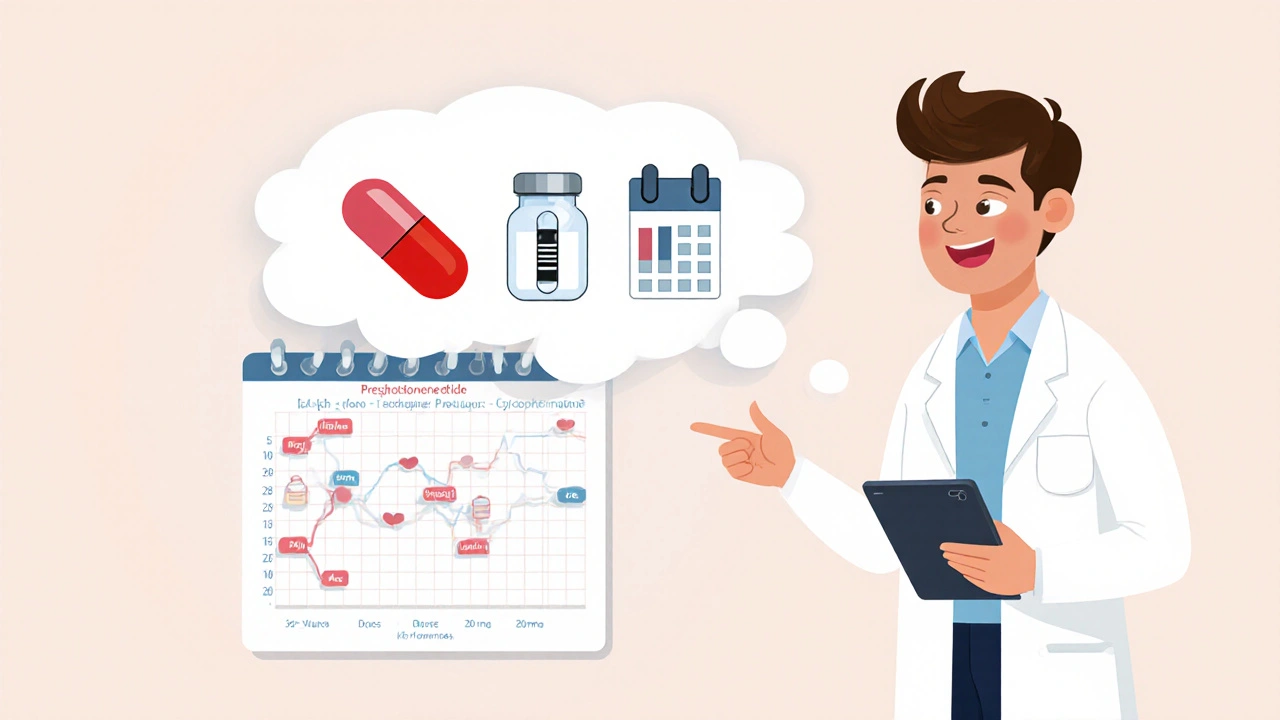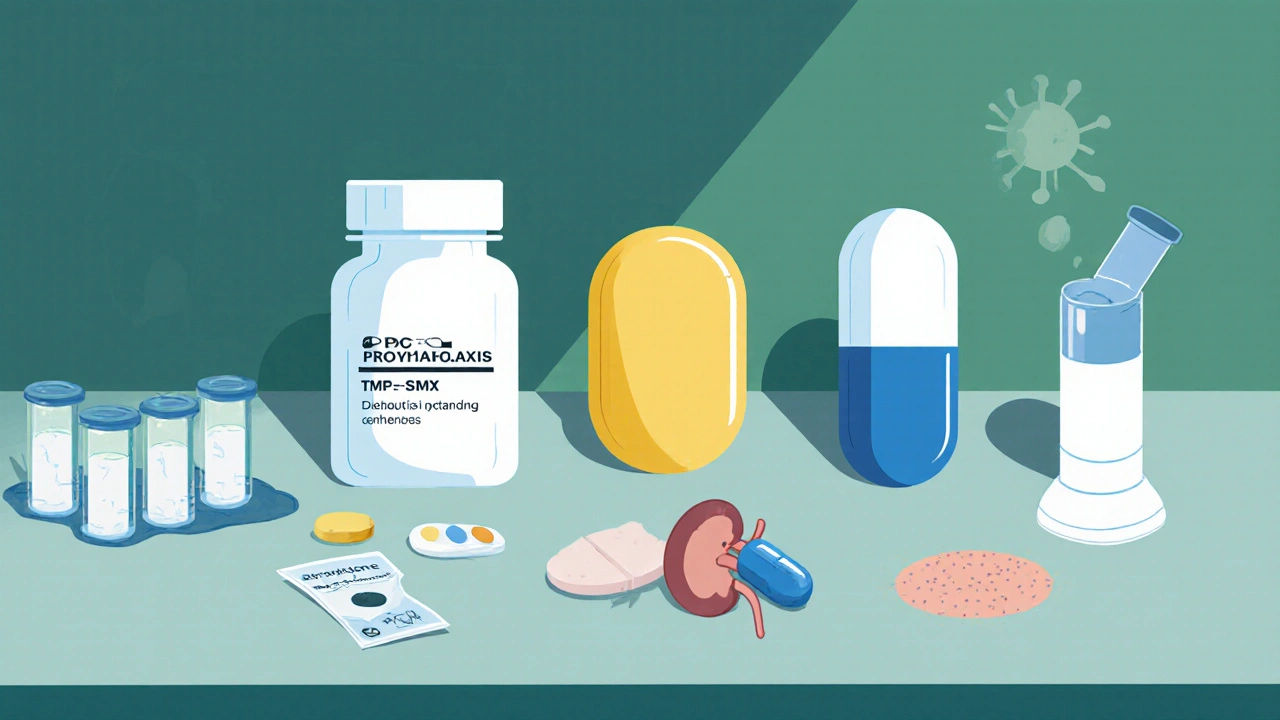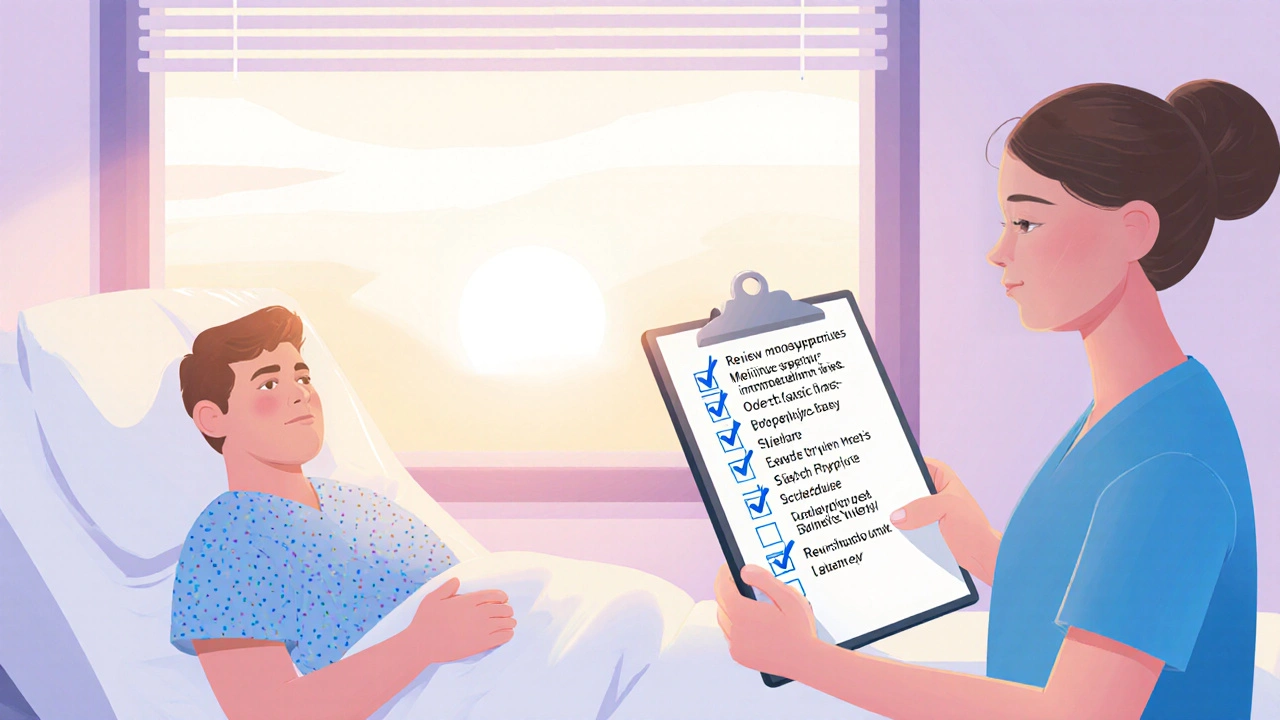Who Needs Pneumocystis Pneumonia Prophylaxis on Immunosuppressants?
 Oct, 25 2025
Oct, 25 2025
PCP Prophylaxis Risk Calculator
This tool helps determine if Pneumocystis pneumonia (PCP) prophylaxis is recommended based on immunosuppressive therapy parameters.
Key Takeaways
- Prophylaxis is recommended for patients on ≥20 mg prednisone daily for 4+ weeks, cyclophosphamide, or combined steroid‑immunosuppressant regimens.
- Trimethoprim‑sulfamethoxazole (TMP‑SMX) remains first‑line; alternatives include dapsone, atovaquone, and aerosolized pentamidine.
- Monitor lymphocyte count, CD4 count, and renal function before and during therapy to catch adverse effects early.
- Risk‑benefit calculation (NNT vs. NNH) helps avoid over‑treating low‑risk patients.
- Documentation of indication and follow‑up plan improves adherence to quality‑metric standards.
When you or a patient starts a strong immunosuppressive regimen, the big question is whether to add a preventive antibiotic for Pneumocystis pneumonia prophylaxis. The infection, caused by Pneumocystis jirovecii pneumonia is a potentially fatal opportunistic fungal disease that mostly strikes people with weakened immune systems. Mortality can exceed 30‑50 % once it sets in, so the stakes are high. Yet not every person on steroids or a disease‑modifying drug needs a daily pill. The answer lies in the dose, duration, and accompanying risk factors - a mix that guidelines try to codify but clinicians still interpret differently.
Who Falls Into the High‑Risk Category?
Guidelines from the CDC, British Columbia Renal Agency, and various specialty societies converge on a few core risk drivers:
- Prednisone ≥20 mg/day (or equivalent) for ≥4 weeks. That threshold appears in multiple provincial protocols and reflects the dose that consistently depresses cellular immunity.
- Use of cyclophosphamide, especially in induction regimens for vasculitis or glomerulonephritis. Evidence shows a higher incidence of PCP even after the drug stops, so prophylaxis should continue for at least three months post‑therapy.
- Combination therapy that pairs corticosteroids with another immunosuppressant such as mycophenolate mofetil or azathioprine.
- Lymphopenia (absolute lymphocyte count <0.5 × 10⁹ cells/L) or CD4⁺ T‑cell count <200 cells/µL, regardless of the drug regimen.
- Active cytomegalovirus (CMV) infection or recent CMV treatment, which signals a broader immune deficit.
If any of these criteria apply, the odds of developing PCP jump into the range where prophylaxis becomes cost‑effective and life‑saving.
Guideline Thresholds in Practice
Different specialties tweak the same numbers. For example, the Ontario Renal Network recommends prophylaxis for all patients receiving cyclophosphamide, while the EULAR 2023 conference suggested adding CD4⁺ counts <200 cells/µL as an extra trigger for autoimmune disease patients on lower steroid doses. The British Columbia Renal Agency explicitly says to stop TMP‑SMX once the steroid dose falls below 20 mg/day, provided the patient’s lymphocyte count has recovered.
Practically, the clinician should perform a baseline assessment:
- Check CBC with differential and CD4⁺ count.
- Screen for active pulmonary infection (chest X‑ray or CT if indicated).
- Document the exact immunosuppressive regimen, dose, and planned duration.
Only after these steps does the decision to start prophylaxis become evidence‑based rather than anecdotal.

First‑Line Prophylaxis and Alternatives
The gold‑standard drug is trimethoprim‑sulfamethoxazole (TMP‑SMX). The CDC and StatPearls both recommend a single double‑strength tablet (800 mg/160 mg) taken once daily, seven days a week. Its effectiveness exceeds 90 % in preventing PCP, and the cost is under $200 per year in the United States.
| Agent | Typical Dose | Key Advantages | Main Side‑Effects |
|---|---|---|---|
| TMP‑SMX | 1 DS tablet daily | Highest efficacy; inexpensive | Rash, cytopenias, renal irritation |
| Dapsone | 100 mg daily | Alternative for sulfa‑allergy | Hemolysis (G6PD‑deficient), methemoglobinemia |
| Atovaquone | 1500 mg daily with food | Well‑tolerated; no bone‑marrow suppression | Gastro‑intestinal upset, high cost |
| Pentamidine (aerosolized) | 300 mg monthly via nebulizer | Useful when oral agents contraindicated | Cough, bronchospasm, thrombocytopenia |
If a patient cannot tolerate TMP‑SMX due to rash or renal impairment, dapsone is the usual second line, unless the individual has G6PD deficiency. Atovaquone is the go‑to for pregnant patients after the first trimester, while aerosolized pentamidine is reserved for severe sulfa allergies where oral options are unsafe.
Monitoring for Adverse Effects
Even the best drug can cause trouble. The first 4-8 weeks are the riskiest period for side‑effects. A practical monitoring schedule looks like this:
- Week 0: Baseline CBC, renal panel, liver enzymes.
- Week 2: Repeat CBC to catch early cytopenia.
- Week 4: Renal function check; inquire about rash or gastrointestinal symptoms.
- Every 3 months thereafter: CBC and renal panel if stable, with additional visits if new symptoms appear.
Patients on dapsone need a G6PD test before starting. Those on atovaquone should take the medication with a high‑fat meal to maximize absorption.
Controversies and Personalized Decision‑Making
Not every specialist agrees on the exact trigger for prophylaxis. A 2023 JAMA commentary highlighted the lack of consensus for autoimmune disease patients on low‑dose steroids (<20 mg) combined with a modest immunosuppressant. Some argue that the number‑needed‑to‑treat (NNT) of ≈ 50 (to prevent one PCP case) outweighs the number‑needed‑to‑harm (NNH) of ≈ 150 for TMP‑SMX‑related rash. Others point out that the cost of a single hospitalization ($25‑$65 k) dwarfs the annual drug cost, tipping the balance toward broader use.
Current research from 2025 suggests even prednisone doses as low as 15 mg/day for three weeks may carry measurable risk, especially when CD4⁺ counts dip below 200 cells/µL. This pushes clinicians toward a more nuanced approach: calculate each patient’s individualized risk based on dose, duration, lymphocyte metrics, and comorbidities, then decide.

Practical Checklist for Clinicians
Turn the evidence into action with a quick bedside checklist:
- Identify immunosuppressive regimen and dose.
- Order baseline labs: CBC, renal & liver panels, CD4⁺ count, lymphocyte count.
- Assess for contraindications to TMP‑SMX (e.g., sulfa allergy, severe renal impairment).
- Choose prophylactic agent based on tolerability and patient‑specific factors.
- Document indication, chosen agent, dose, and monitoring plan in the EMR.
- Schedule follow‑up labs at weeks 2, 4, then quarterly.
- Re‑evaluate need after 3 months of steroid taper or after cyclophosphamide completion.
Ticking these boxes not only protects patients but also satisfies CMS quality‑metric reporting for appropriate PCP prophylaxis.
Economic Impact and Health‑System Perspective
From a health‑system view, PCP is a high‑cost outlier. A 2023 HCUP analysis reported average hospital charges of $45 k per episode, while a year of TMP‑SMX prophylaxis runs under $200. Even accounting for the 2‑3 % adverse‑event rate, the cost‑benefit ratio strongly favors prophylaxis in high‑risk groups.
However, over‑prescribing can inflate pharmacy budgets and raise concerns about antibiotic stewardship. The 2021 Journal of Antimicrobial Chemotherapy found no rise in community resistance linked specifically to prophylactic TMP‑SMX, but the perception persists. Clear documentation and targeted use help align cost control with patient safety.
Bottom Line
Deciding who needs Pneumocystis pneumonia prophylaxis isn’t a one‑size‑fits‑all choice. Focus on steroid dose ≥20 mg/day, cyclophosphamide use, combined regimens, and measurable lymphocyte depressions. Start TMP‑SMX unless contraindicated, monitor labs closely, and revisit the need as therapy tapers. By embedding a simple checklist into the workflow, clinicians can close the gap between guideline recommendations and everyday practice.
When should prophylaxis be stopped?
Stop TMP‑SMX once the prednisone dose falls below 20 mg/day and the patient’s absolute lymphocyte count is >0.5 × 10⁹ cells/L for at least two weeks. For cyclophosphamide, continue for three months after the last dose.
What if a patient is allergic to sulfa drugs?
Dapsone is the preferred second line, provided the patient has normal G6PD activity. If dapsone is unsuitable, atovaquone offers a well‑tolerated oral option, though it is more expensive.
Does pregnancy change the prophylaxis choice?
TMP‑SMX can be used throughout pregnancy, but avoid aerosolized pentamidine and atovaquone in the first trimester due to limited safety data. Discuss risks with obstetrics.
How often should labs be checked while on prophylaxis?
Baseline labs, then repeat CBC and renal panel at weeks 2 and 4, followed by quarterly checks if stable. Promptly investigate any new rash, fever, or GI upset.
Is there a role for CD4 testing in non‑HIV patients?
Yes. A CD4⁺ count <200 cells/µL, even in non‑HIV settings, flags severe immunosuppression and often triggers prophylaxis, especially when combined with steroids.

Melanie Vargas
October 25, 2025 AT 14:35Great summary! 😊 For anyone juggling high‑dose prednisone, adding TMP‑SMX early can save a lot of hassle down the road. Just make sure to check renal function before you start, and keep an eye on any rash or cytopenias. It’s also a good idea to document the indication in the chart so the team stays on the same page. Cheers to keeping patients safe! 👍
Deborah Galloway
October 27, 2025 AT 08:15I love how the key takeaways are laid out-super clear. When you’re on a combo like mycophenolate plus steroids, I always pull the CD4 count even though it’s not a classic HIV marker; it gives a nice sense of cellular immunity. If the count dips below 200 cells/µL, I’m quick to start prophylaxis. Also, reminding patients to report any new skin or GI symptoms can catch sulfa reactions early. Keep the info coming! 🌟
Ken Dany Poquiz Bocanegra
October 29, 2025 AT 01:55TL;DR: ≥20 mg prednisone for >4 weeks → start TMP‑SMX, monitor CBC and kidney; otherwise, hold off.
krishna chegireddy
October 30, 2025 AT 19:35Ah, the magic bullet oversimplifies a nuanced immunologic reality-big pharma loves that narrative. 😏
Tamara Schäfer
November 1, 2025 AT 13:15Honestly, the guidelines feel like a moving target. One minute you’re told 20 mg of prednisone is the cut‑off, the next you see a “low‑risk” modifier based on age or comorbidities. I think the biggest gap is real‑world adherence; many clinics still rely on paper checklists that get lost in the shuffle. It would be helpful if EMR alerts popped up when a patient crosses that 4‑week mark. Also, consider that TMP‑SMX can cause hyperkalaemia, especially in patients with baseline CKD-so daily labs are a must. For those who can’t tolerate sulfa, dapsone is an option, but watch for G6PD deficiency. Lastly, patient education is key: let them know why the prophylaxis is not “just another pill” but a life‑saving measure. (oops, typo: “lifesaving” vs “life‑saving” )
Tamara Tioran-Harrison
November 3, 2025 AT 06:55Well, if reading dense guidelines were a sport, we’d all be Olympic gold medalists. 🙄
Max Lilleyman
November 5, 2025 AT 00:35Bottom line: don’t let “low‑risk” become a loophole. The NNT for PCP prophylaxis in high‑dose steroid patients hovers around 30, while the NNH for severe rash can be much higher if you monitor properly. So, err on the side of prevention, especially when the patient has lymphopenia. 🚀
Shannon Stoneburgh
November 6, 2025 AT 18:15Guidelines are fine; execution is what kills.
Jennifer Stubbs
November 8, 2025 AT 11:55From a health‑system perspective, documenting the indication for TMP‑SMX not only satisfies quality metrics but also streamlines pharmacy approvals. In practice, a simple template in the progress note-dose, duration, risk factors-cuts down on back‑and‑forth with the team. Also, remember that aerosolized pentamidine, while effective, can be cumbersome for outpatient use and may not be covered by all insurers. So, always have an alternative plan ready.
Sarah Keller
November 10, 2025 AT 05:35The debate over universal PCP prophylaxis in patients receiving immunosuppressants is more than an academic exercise; it directly impacts morbidity and mortality across specialties. When a rheumatologist initiates high‑dose prednisone for vasculitis, the underlying disease already predisposes the patient to infection, and adding a steroid amplifies that risk. Conversely, a dermatologist prescribing a short course of azathioprine for psoriasis may not cross the threshold that justifies routine prophylaxis. The literature consistently shows that a CD4 count below 200 cells/µL, or an absolute lymphocyte count under 500 cells/µL, correlates with a steep rise in PCP incidence, regardless of the specific agent. Moreover, cyclophosphamide, especially in induction regimens, has a lingering immunosuppressive effect that can persist months after the drug is stopped, necessitating continued coverage. TMP‑SMX remains the gold standard not merely because of its efficacy but also due to its cost‑effectiveness and broad antimicrobial spectrum, which can cover incidental bacterial infections. However, clinicians must balance this with the potential for sulfa‑related hypersensitivity, renal insufficiency, and hyperkalaemia, all of which can be mitigated by baseline labs and close monitoring. In patients with G6PD deficiency, dapsone offers a viable alternative, though hemolytic risk remains a concern. Atovaquone, while well‑tolerated, is often prohibitive due to price and insurance hurdles. Aerosolized pentamidine is another option, yet its administration logistics make it less attractive for outpatient maintenance. From a systems‑level view, documenting the prophylaxis indication in the electronic health record creates an audit trail that satisfies both payer requirements and internal quality dashboards. This documentation also facilitates handoffs between inpatient and outpatient providers, ensuring continuity of care. Education of the patient is equally critical; explaining that the prophylaxis is a protective measure rather than an unnecessary drug can improve adherence. Finally, the decision should be individualized: assess the cumulative steroid dose, the presence of lymphopenia, any concurrent cytotoxic agents, and comorbid conditions such as diabetes or chronic lung disease. By taking a nuanced, risk‑stratified approach, clinicians can avoid both overtreatment and the catastrophic consequences of missed PCP prophylaxis.